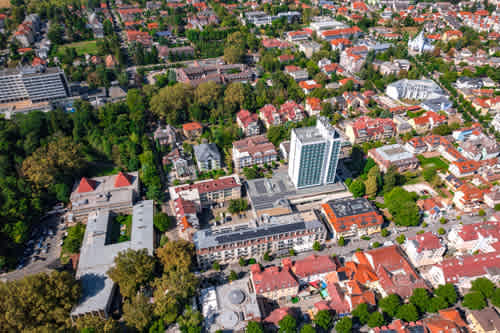About Zala
Zala, one of Hungary’s 19 counties, is home to some of Hungary’s most beautiful landscapes.
Zala, one of Hungary’s 19 counties, is located in the southwestern part of Hungary bordering Slovakia and Croatia and is home to some of Hungary’s most beautiful landscapes. Here are some basic facts about Zala to start acquainting you with this lovely region.
At 1461 square miles, Zala is one of Hungary’s smaller counties, and its population of about 300,000 also ranks it among the country’s less densely populated areas. Two rivers flow through it, the Zala River- which gave it its name - and the Mura River. The western part of Lake Balaton, the largest lake in Central Europe and the site of the famous Blue Ribbon Regatta (sailing race), is also located here. The entire area is covered with forests, and the terrain is mountainous, resulting in a pleasant climate – in fact, one of the most comfortable climates in Hungary.
And now for some history in a nutshell… King Stephen I, also known as Saint Stephen or as Szent István in Hungarian, established Zala in the 11th century, but its golden era didn’t come until the 15th century, during the reign of King Matthius Corvinus (Matyas in Hungarian). In the 16th and 17th centuries, during the wars with the Turks, this area was an important strategic stronghold due to its proximity to the Austrian border which, at that time, was the decisive blockade against the Turks. The 18th century brought a period of prosperity, both economically and culturally. The 19th century is marked by the rule of Franz Josef, King of Hungary, Emperor of Austria and the other lands of the Hapsburg monarchy, which he reconstituted as the Austro-Hungarian Empire. The 20th century and the takeover by the Communists brought periods of instability with many changes and upheavals, but, with the fall of Communism in 1989, Hungary transitioned into a democracy.
The region has developed tremendously over the years in terms of its economy, industry, agriculture, and education. It has become a center of tourism which attracts many visitors, both local and foreign, because of its outstanding natural beauty and the abundant healing springs which are now part of attractive spas. A combination of the nature, the local art, and the warm hospitality of the locals, as well as the largest thermal lake in Europe – Lake Heviz – make Zala a top vacation destination.
Zala is divided into three sub-districts:
Gocsej, an area of about 260 square miles, is surrounded by barren low hills. The local Gocsej Village Museum, an open-air ethnographic museum, is a great source for learning about the history and culture of this district. The second district is Hetes Zala which is situated near the border with Slovakia, and the third, and the most important for tourists, is the one bordering the popular Lake Balaton which, at 231 square miles, is the largest lake in Europe.
The main tourist season at Lake Balaton goes from May to the end of September, but off-season is a great time to visit, especially since there are fewer crowds. There are some beautiful resort towns in the surrounding area, such as Keszthely, Gyenesdiás, Vonyarcvashegy, and Balatongyörök which are ideal for family vacations. The lake is a particularly relaxing vacation spot with its pleasant waters, sandy beaches, and pools for all ages. You can also enjoy water skiing, boating, and fishing on the lake, and, because of the ban on motor boats, the lake water is particularly clean and fresh. For additional recreation, there is horseback riding available on the nearby horse farms, and there are many hikes of all lengths and difficulty in the area. End your day with an outstanding Hungarian meal in one of the town's restaurants along the way.
If you’re looking for other pretty cities scattered in the region, visit Zalaegerszeg, Nagykanizsa, Balatongyorok, Pacsa, and Lenti. You may not be able to pronounce their names, but you will easily find the fun, enjoyable attractions in each location!




